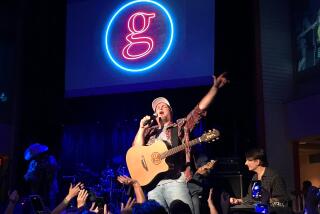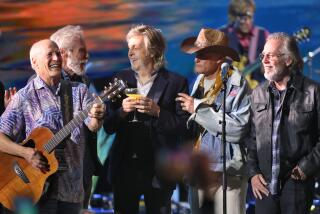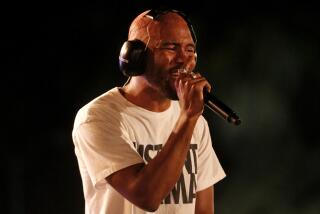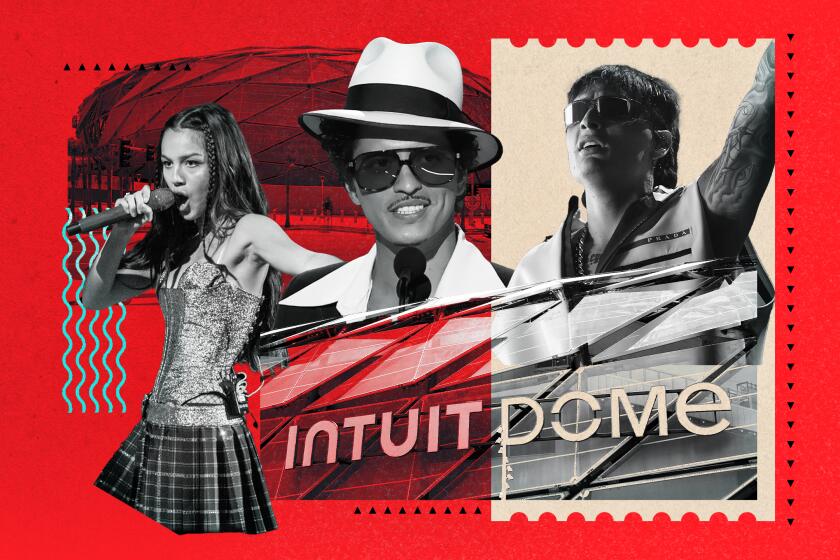Bakersfield Sadly Says ‘So Long’
BAKERSFIELD — Country singer Buck Owens recorded a lot of geographically minded songs during his long career -- some hits (“Big in Vegas,” “Made in Japan”), some not (“Hollywood Waltz”) -- but there was only one that mattered Saturday to the hundreds of fans bidding him goodbye.
“Streets of Bakersfield,” the anthem of civic pride that gave him the last of his 21 No. 1 country hits, echoed regularly through the rhinestoneaccented interior of Buck Owens’ Crystal Palace, the restaurant and nightclub he opened in 1996 and where he had played close to 1,000 shows, virtually every Friday and Saturday night.
On Saturday, Owens, who died a week earlier at 76, was on that dance floor once last time, clothed in a crisp black Western suit and a tomato-red shirt inside an open casket. A black Western hat rested over his folded hands as onlookers from Bakersfield and beyond streamed past throughout the day.
“You think of Bakersfield, you think of Buck,” said Lake Isabella resident Vern Alford, pausing to talk under a blue sky painted with white and gray clouds between spring rainstorms. “He made this town what it is.”
Alford once played guitar with Owens as part of the house band at the celebrated honky-tonk bar the Blackboard. That was where Owens honed his sound and learned how to keep patrons happy and dancing.
Owens put Bakersfield on the map musically, helping establish a distinctly West Coast country style. What came to be known as “the Bakersfield sound” was dominated by catchy, upbeat, electric-guitar-driven hits like Owens’ “Act Naturally,” “I’ve Got a Tiger By the Tail” and “My Heart Skips a Beat,” songs that contrasted starkly to the piano- and violin-heavy sound popular in Nashville at the time.
He recorded Homer Joy’s “Streets of Bakersfield” twice, including a 1988 duet with Dwight Yoakam. It spoke of his undying and unapologetic allegiance to the town he’d made his home for more than 50 years.
The town made clear it returned the affection on Saturday, suspending a 20- by 40-foot American flag above the famous Bakersfield arched sign outside the Crystal Palace.
“That sign there says it all,” said Dorothy Alford, Vern Alford’s wife, pointing to the arch.
The sign that had long announced to travelers that they had reached Bakersfield had fallen into disrepair and was marked for demolition in 1999. But Owens stepped in and paid to refurbish and move it from Bakersfield’s former main drag to the Crystal Palace so it would be instantly visible to travelers on California 99 a few hundred yards away.
Owens’ musical legacy figures to be the focal point of today’s funeral service at Valley Baptist Church. But Saturday’s all-day public viewing gave a forum to fans and fellow Bakersfield residents to talk about his role as the richest man in town, one whose savvy investments over the years in TV and radio stations anchored an empire once estimated to be worth more than $100 million.
But the music giant never let his fortune separate him from working people in this oil and agriculture town.
“Buck was never the kind of person who thought he was better than you,” said Joyce Fox, accompanied by her husband, Dennis.
“If you were walking down the street, he’d say hi to you before you’d talk to him. “He’d shout out, ‘How the hell you guys doing?’ ” she recalled after walking the circuit others traced through the Crystal Palace.
She passed bronze statues of Owens, Johnny Cash, Hank Williams, Willie Nelson, Elvis Presley and other musicians as well as display cases with the metal-flaked Fender guitars that Owens favored and the eyepopping Nudie Cohen-designed suits he and his Buckaroos band sported during their heyday.
“Buck is everywhere here,” said Barbara Stephens, a septuagenarian who engaged in a friendly debate with 46-year-old Joe Stormont over which of them had seen him more times in the last decade.
Stormont spent his Friday nights at Owens’ Crystal Palace performances, Stephens her Saturday nights, each estimating they’d been on hand for some 500 shows.
“I took my dog down to the SPCA the other day, and there was his name on a door, the Buck Owens Room,” Stephens said. “At San Joaquin Hospital they have the Buck Owens Wellness Center. He did a lot of things nobody ever saw.”
The singer, songwriter and businessman’s presence ran deep, through his contributions to local hospitals, support of law enforcement and firefighting programs and his charity golf tournament and rodeo, which raised money for cancer prevention programs.
The crowd Saturday included musicians who once played with Owens, who perhaps was most famous for his 17-year run on the country music variety show “Hee Haw.” There were also dozens who worked for him or whose sons, daughters or parents did.
Several recalled his sense of loyalty to fans, noting that he had performed a show, despite feeling ill, the night before he died.
“When he walked on stage that night, he had a strange look that I’d never seen, like he was in pain or upset about something,” said Crystal Palace veteran Stormont. “But as soon as the lights hit him, he flashed that smile and threw his hands in the air.... That’s the kind of man he was.”
The Crystal Palace has been closed since Owens’ death but is scheduled to reopen Tuesday.
“I’ve been on that stage with him a thousand times, just that stage, not counting everything else we’ve done in the 36 years I’ve been with him,” said Buckaroos keyboardist and family spokesman Jim Shaw.
“It’s going to be very hard to step out there again the next time and know he’s not going to be there.”
More to Read
The biggest entertainment stories
Get our big stories about Hollywood, film, television, music, arts, culture and more right in your inbox as soon as they publish.
You may occasionally receive promotional content from the Los Angeles Times.










